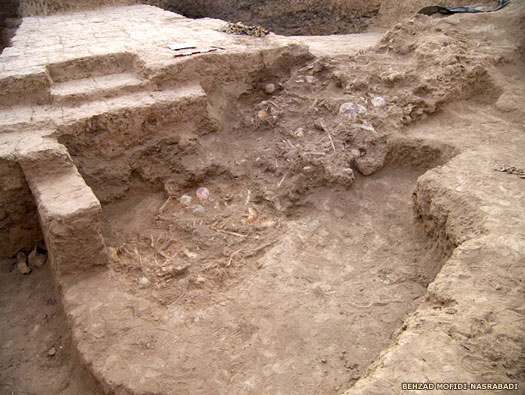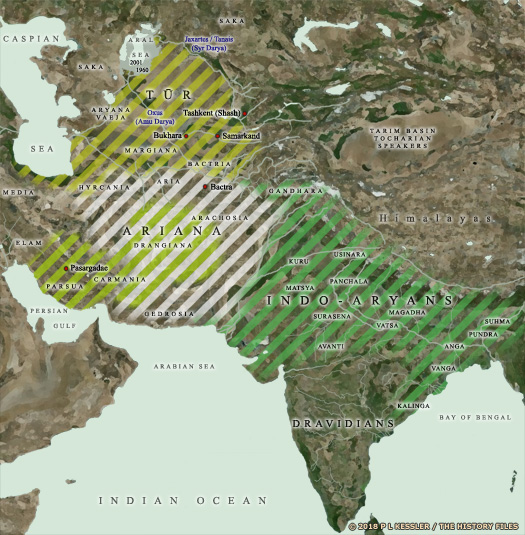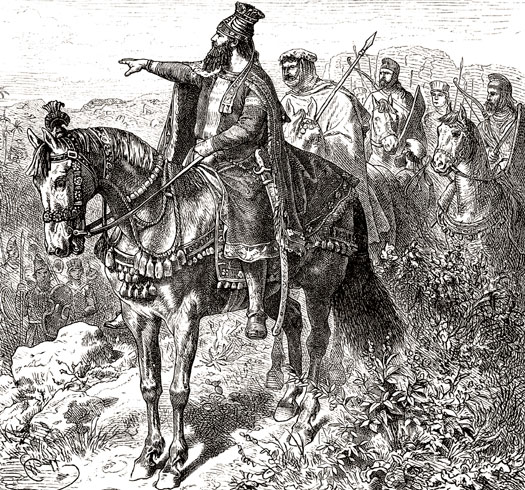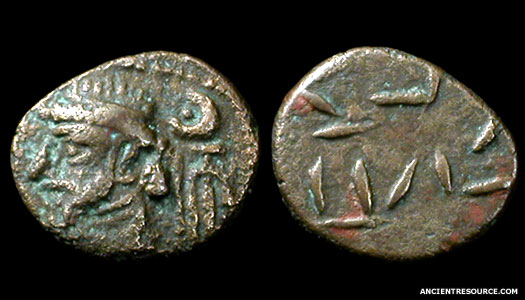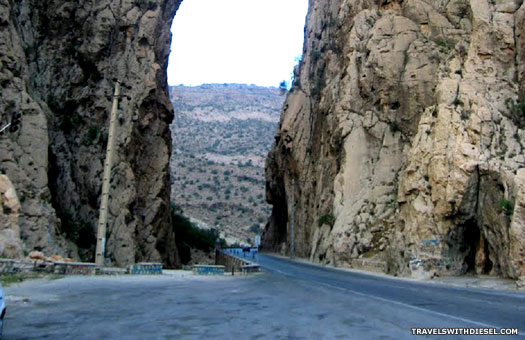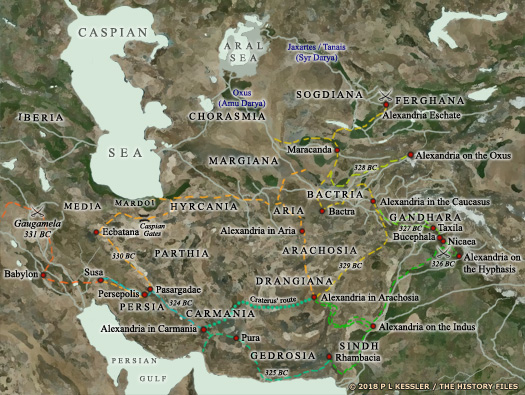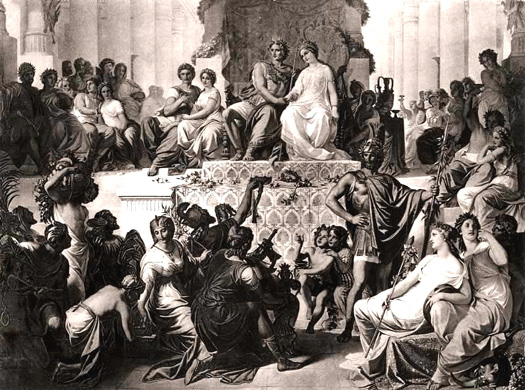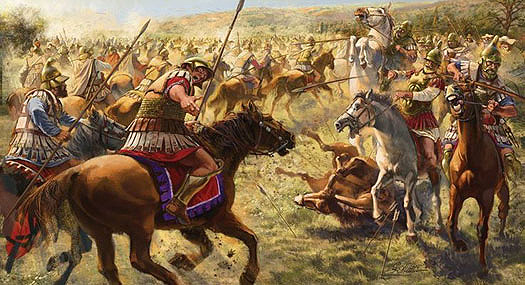
| ELAM / HALTAMTU / SUSIANA Elam was one of the longest-surviving kingdoms in history in one of the oldest civilised areas in the world. It was founded by circa 2700 BC and was situated in south-western Iran, on the east bank of the Tigris from modern Kuwait along the coast of the Persian Gulf (approximately the modern region of Khuzestan and Ilam Province, the latter of which inherits the former kingdom's name).
Culturally, the kingdom achieved less than its advanced neighbours, and imported much of what it needed, including writing from Sumer and architecture from the later Babylon. From the few surviving records, it seems the Elamite language bore no relation to any others; Semitic, Sumerian or Indo-European, forming part of a group called Elamo-Dravidian which reached into India. Elamite records are also extremely sparse in recording local events, and large areas of their history are almost totally unknown except through Sumerian records.
The form of the kingdom's name, 'Elam' (meaning 'highland'), is Akkadian (and through them, Hebrew), while in the original Elamite form it was Haltamtu or Haltamti. It was also known in classical writings as Susiana, from the city state of Susa which usually formed its capital. The Old Testament claims Elam as a son of Shem, ancestor of the Israelites, and founder figure of the kingdom bearing his name. The Elamites, however, certainly were not Semites. Their language is considered to be a linguistic isolate, not linked to later-arriving language-speakers such as the Semites. The kingdom's four major cities were Awan, Anshan, Simash, and Susa, the capital, a hundred kilometres (seventy-five miles) east of the Tigris, in which the rulers practised kingship by matrilineal descent, being referred to as 'son of a sister'.
from 7000 BC :
The first traces of civilisation appear in the Elamite region. Susa shows traces of early settlement.
c.4000 BC :
Susa emerges as an important regional centre.
c.3200 - 2700 BC :
The Proto-Elamite Period witnesses the development of a semi-pictographic writing system. Susa begins to be influenced by the cultures of the Iranian Plateau to the east, and dominates the lowlands to the west of the Zagros Mountains. Approximately 400 kms to the south, Anshan, in the modern province of Fars, becomes prominent and expands in size, dominating the highlands of the southern mountain range.
Old Elamite Period :
The Old Elamite Period marks the beginnings of the historical era in Elam and relations with the flourishing Sumerian city states. Three dynasties of kings ruled, with the last of them forming a short-lived empire. It seems that at various times, Anshan and Susa were ruled as separate kingdoms, and were perhaps only briefly united within one state. However, Sumerian writings start referring to them as the land of Elam, suggesting an element of unity, perhaps as a loose coalition of city states.
c.2600 BC :
According to the Sumerian king list, the ruler of the city state of Kish subdues Elam.
Avan / Awan Kings :
The founding of the Awan dynasty of Elamite rulers ended the hazy Proto-Elamite Period, although precise details of their rule are extremely fragmentary. Awan was one of Elam's four major cities, located to the immediate north-west of Susa, and the first three kings are mentioned on the Sumerian king list, in the fourth set of post-diluvian entries. The first foreign rulers of Sumer, they briefly held dominance there, having gained the kingship from Lagash or more probably Umma (although these cities are missing from the list, and the dating is misaligned).
FeatureAccording to the king list, a total of three kings of Awan ruled Sumer for 356 years, once (one dynasty) in Awan. This is the fourth set of entries on the list comprising kings 40-42, but the text was destroyed in this section. Here, List 1 is primarily used, backed up by List 2.
c.2550 - ? BC :
(Name Unknown) : Ruled for ? years, holding dominance in Sumer.
(Name Unknown) : Ruled for ? years, holding dominance in Sumer.
(Name Unknown) : Ruled for ?/36 years, holding dominance in Sumer.
Awan is defeated and the Sumerian kingship passes to Kish. It could be possible that the following three kings are the same as the three unnamed kings who had dominated Sumer. Their dates are much closer to fitting in with those in which the kings of Awan could have seized power from Lagash or Umma and ruled for about forty years.
fl c.2450 BC :
Peli
Some lists place three kings of Ebla after Peli as Awan kings. However, the names seem to be Syrian ones: Igrish-Halam, Irkab-Damu, and Ar-Ennum.
c.2450 BC :
Eannatum of Lagash extends his power to parts of Elam and the Persian Gulf, and the succeeding rulers of Lagash engage in contests against Elam for the next century or so.
c.2430 BC :
Enshakushanna of Uruk throws the Elamites out of Awan.
Tata / Taar / Tari
Ukku-Takhesh
Khishur / Hishur
Shushun-Tarana
Napil-Khush
Kikku-Sive-Temti
fl c.2350/2325 BC :
Lukh-Ishshan
c.2350 BC :
Elam is reputedly conquered by Alusarsid of Akkad. At the same time a kingdom or confederation known as Marhashi is emerging to the east, on the Iranian Plateau.
fl c.2320 BC :
Khishep-Ratep / Hishep-rasher : Vassal of Akkad?
Eshpum : Ruled? Vassal of Akkad?
Ilishmani : Ruled? Vassal of Akkad?
Epirmupi : Ruled? Vassal of Akkad?
c.2300 - 2280 BC :
Khelu / Helu : Vassal of Akkad?
c.2280 - 2250 BC :
Khita / Hita : Vassal of Akkad?
c.2278 - 2270 BC :
After an attempted rebellion, Elam is re-conquered by Rimush of Akkad, and real Elamite history can be traced from this point. The state of Marhashi is now a cohesive entity, bordering Anshan to the east.
Shimpishuk : Ruled? Vassal king?
c.2240? BC :
Both Marhashi and Kutik-Inshushinnak declares independence from Akkad (although perhaps not immediately as it seems they are re-conquered for a time), eventually throwing off Akkadian language influences. The ruler conquers Susa and Anshan, forming a centralised and unified kingdom.
c.2240 - 2220 BC :
Kutik (or Puzur)-Inshushinnak : Governor and general of Susa & king of Awan.
Tazitta I
c.2210 BC :
Marhashi overruns Elam for a time, and unites eastern efforts in fighting against the Akkadian empire. A battle is fought near Akshak, at the confluence of the Diyala and Tigris rivers between the two states.
c.2193 BC :
Elam is overthrown by the Gutians as they sweep through southern Mesopotamia from the Zagros Highlands, also destroying the Akkadian empire. The new Simash dynasty eventually comes to power during a period of instability.
Eparti
fl before 2120 BC :
Tazitta II
Simash Kings :
Although records are characteristically sparse, it seems that the invading Gutians caused the downfall of the former ruling dynasty in Elam, and their replacements, the Shimashki, faced a period of alternate diplomacy and attack from the Gutians and Sumerians. Some names may not be in the same order on all lists.
?
?
c.2050 BC :
Elam loses its capital at Susa when it is conquered by Shulgi of Ur.
fl c.2030? BC : Gir-Namme
fl c.2010? BC : Enpi-Luhhan
fl c.2007? BC : Khutran-Temtt
fl c.2004 BC : Kindattu
c.2004 BC :
Kindattu, together with the people of Susa, sacks Ur and lead its king into captivity. ending the third dynasty. With this threat removed, Elam becomes a powerful kingdom, although it is pushed out of southern Mesopotamia six years later by the Amorite city state of Isin. However, Elam appears to hold on to Kish.
Indattu-Inshushinnak I
Tan-Rukhurater
Indattu-Inshushinnak II
Indattu-Napir
Indattu-Tempt
Eparti Kings :
Under the stronger Eparti kings the Elamites swiftly rose to become a regional power, being contemporaneous with the Old Babylonian empire, and threatening it and the other Amorite city states, such as Isin, with conquest. The Eparti were also called 'of the sukkalmahs' due to the title which their kings bore. In some lists the Eparti are included as Simash/Shimashki kings. Details on rulers is extremely sparse, and some names may not even be in the correct order.
Recent excavations (up to 2015) that have been led by archaeologist Behzad Mofidi-Nasrabadi of Mainz University at the site of Haft Tepe or Tappeh (approximately twenty kilometres from Susa) have uncovered a workshop with an attached clay tablet archive that dates to this period in which the city is a prominent centre in the Elamite empire. The workshop records the expansion of commerce, arts, and crafts. Physical evidence of this prosperity includes lavish grave goods that have been found in the tomb of a female official, and a well-crafted female figurine.
c.1970 BC :
Eparti I
Eparti II
fl bef. c.1850 BC :
Eparti III
c.1835 BC :
Kudur-mabug : King of an Elamite state north of Susa? In Zagros Mountains?
c.1835 BC :
Kudur-mabug, apparent king of an otherwise unknown Elamite state to the north, manages to install his son, Warad-Sin, on the throne of Larsa.
Shilkhakha
fl after c.1830 BC :
Attakhushu
Tetep-mada?
fl c.1792 BC :
Sirukdukh
c.1772 - 1763 BC :
Shimut-Wartash
c.1770? - 1765 BC :
Elam apparently takes control of the city of Apum after the fall of the kingdom of Upper Mesopotamia. Elamite rule is eventually thrown out when the city of Andarig takes control there.
c.1763 BC :
Following an attempted invasion the previous year (during which Ekallatum is conquered by Elam), the Elamites are defeated in southern Mesopotamia by Hammurabi's Babylonian empire, and the kingdom begins a period of vassalage to Babylon, still with their own kings, although the region's previous political unity is probably shattered.
c.1763 - 1745 BC :
Siwe-Palar-Khuppak : For a time the most powerful ruler in the area.
c.1750 BC :
Kudur Lagamar : King Chedorlaomer of the Bible, but existence is unconfirmed.
c.1745 - 1730 BC :
Kuduzulush I
c.1732 BC :
Elam loses control of Kish to the kings of Sealand.
c.1730 - 1700 BC :
Kutir-Nahhunte I
c.1700 - 1698 BC : Lila-Ir-Tash
c.1698 - 1690 BC :
Temti-Agun I
c.1690 - 1655 BC :
Tan-Uli
c.1655 - 1650 BC :
Temti-Khalki
c.1650 - 1635 BC :
Kuk-Nashur II
c.1635 - 1625 BC :
Kutir-Shilkhakha I
c.1625 - 1605 BC :
Temti-Raptash
c.1605 - 1600 BC :
Kuduzulush II
c.1600 - 1580 BC :
Tata
c.1595 BC :
It appears that at the same time as they take control in Babylon, the Kassites are able to devastate Elam.
c.1580 - 1570 BC :
Atta-Merra-Khalki
c.1570 - 1545 BC :
Pala-Ishshan
c.1545 - 1520 BC :
Kuk-Kirwash
c.1520 - 1505 BC :
Kuk-Nahhunte : Plundered the temples of Amorite Akkad.
c.1505 - ? BC :
Kutir-Nahhunte II
c.1500 BC :
Perhaps due in part (at least) to the devastation of Elam of a century before, the kingdom has entered a slow decline into obscurity.
Middle Elamite Period :
The Middle Period began as a poorly recorded period thanks to the Kassite rule of Babylonia, but this was followed by a slow ascendancy into an empire under three dynasties of kings from the city of Anshan. Although Elam was a late arrival on the international scene, and had limited influence outside Babylonia and Assyria, it cannot be ignored as a significant force. The lack of international correspondence relating to it probably comes from its rise after the period of the Egyptian Armana archive and its distance from Syria. To be able date any of these rulers, events that are noted in Babylonia have to be relied upon.
Kidinuid Kings :
The Anshanites dynasties began with the Susa-based Kidinuids, who oversaw the 'Elamisation' of Susa, while continuing to use the Akkadian language on their inscriptions. The kings of this period were titled 'king of Anshan and Susa', indicating a renewed political unity within Elam, or at least a claim to it. This is the most obscure of the three Middle Period dynasties.
c.1500 - ? BC :
Kidinu
Inshushinak-sunkir-nappipir : Some lists place him last.
Tan-Ruhurater II
Shalla
? c.1400 BC :
Tepti-ahar
The best-attested act of this period is Tepti-ahar's building of a new settlement, called Kabnak (modern Haft Tepe or Tappeh), approximately twenty kilometres from Susa. These kings leave no mark outside of the western lowlands. However, with Elam in decline, Kabnak (Haft Tepe) also declines. Some of its temples and palaces are abandoned, and their materials are reused to build simple dwellings. The remains of several hundred massacre victims of this period are found by archaeologists in 2014-2015, piled on top of one another behind one of the city's internal walls.
Several hundred people were massacred in this period and their bodies piled into a mass grave behind one of Kabnak's city walls, for archaeologists to find in 2014-2015, although the circumstances surrounding the massacre are unknown Igehalkid Kings :
Ige-Halki ruled a newly independent, and certainly reunified Elam, with the lowlands of Susa in the west once more united with the highlands of Anshan in the east. Elamite language continued to increase in importance during this period. However, under the rule of the Igehalkids the kingdom seems to have remained fairly inactive. Ten rulers are known, but there may be more. The succession of kings was unusual for the period in that the throne moved back and forth between the descendants of two sons of Ige-Halki.
c.1350 - 1330 BC :
Ige-Halki : Or from c.1400 BC.
c.1330 - 1310 BC :
Pakhir-Ishshan : Son.
c.1320 BC :
Elam is temporarily occupied by the Kassites.
c.1310 - 1300 BC :
Attar-Kittakh : Brother.
c.1300 - 1275 BC :
Khuman-Numena : Son.
c.1275 - 1240 BC :
Untash-Naprisha : Son.
The largest project undertaken by the dynasty is the construction of a new city 40km from Susa. The city of Al-Untash-Naprisha is named after its founder, and is devoted to Napirisha, the great god of Elam, and Inshushinak, the patron deity of Susa. After the king's death, his city assumed secondary status to Susa.
c.1240 - ? BC :
Unpatar-Naprisha : Descendant of Pakhir-Ishshan.
Kiddin-Khutran I : Brother.
Kiddin-Khutran II : Descendant of Attar-Kittakh.
? - c.1220 BC :
Napirisha-Untash : Son.
c.1220 - 1200 BC :
Kiddin-Khutran III : Son?
c.1230 BC :
Kiddin-Khutran enters Babylonia twice to attack Assyria's puppet rulers there. On the first campaign, Nippur is taken, while on the second Isin is attacked. When Kiddin-Khutran dies there is a change of dynasty in Elam.
Shutrukid Kings :
It is not known how this new dynasty came to replace the previous one. Under the Shutrukids the kingdom again became a powerful force within Mesopotamia, even being able to reach out and conquer Babylon. Unfortunately, that expansion brought about the destruction of Elam and four hundred years of direct Babylonian rule. Dates are extremely uncertain, and do not entirely align with events in Babylonia.
c.1210 - 1190 BC :
Khallutush-In-Shushinak
c.1190 - 1160 BC :
Shutruk-Nahhunte I : Rebuilt the kingdom.
c.1158 - 1155 BC :
Once again a rising power, Shutruk-Nahhunte marries the eldest daughter of the Babylonian king Melishipak, and appears to claim Babylonia as his own. He is able to push the Kassites out, forming a short-lived empire that encompasses Mesopotamia, with his eldest son on the Babylonian throne.
c.1160 - 1155 BC :
Kutir-Nahhunte III : Son. King of Babylon (1158-1155).
c.1155 - 1125 BC :
Shilkhak-In-Shushinak : Brother.
c.1155 - 1135 BC :
While his brother is later accused by Babylonian sources of having plundered the country, Shilkhak-In-Shushinak claims to raid Babylonia and Assyria repeatedly, and to control the area east of the Tigris as far north as Nuzi, until being expelled by the new Isin kings of Babylonia.
c.1125 - 1115 BC :
Khutelutush-In-Shushinak : Result of probable relationship between his father & sister.
c. 1115 - ? BC :
Shilhana-Hamru-Lagamar : Brother.
Neo-Elamite Period :
The Middle Period ended with the sacking of Elam and further occupation by Babylonia. Elam never quite recovered from this and the neo-Elamite Period was one of Iranian and Syrian influence, and especially Assyrian, and obscurity for the Elamites themselves.
(Additional information from The Persian Empire, J M Cook (1983).)
c.1120 - 760 BC :
Neo-Elamite Period I sees Elam's capital, Susa, sacked by the Babylonian king, Nebuchadrezzar. The kingdom is badly damaged, and is absorbed into Babylonia.
c.843 BC :
The early Persians or, perhaps more accurately, the Parsua, receive their first mention in history. The Assyrian king, Shalmaneser III, records their existence on the Black Obelisk, which covers his campaign of about this year. Their position is not precisely fixed but 'Pasua' seems to lay in what is now Iranian Kurdistan (immediately east of Kurdistan in northern Iraq), far to the north of Persis and the heart of Persian settlement.
It may be the case that there are two (or perhaps even three) distinctive groups of 'Parsua' at this time, primarily in the Zagros Mountains to the east and south-east of the Assyrians. This is apart from a larger body which is settling the land immediately to the east of Elam (and focussed around the city of Persis). Those groups in the Zagros seem to drop out of the historical record, perhaps pushed south by the greater numbers of the Medes or absorbed by them.
c.760 - 644 BC :
Neo-Elamite Period II sees Elam, under its Babylonian masters, controlling the Persians to the east of Elam itself, who had begun to migrate into the area from around 1000 BC. Elam and Babylonia often fight side by side against external threats, especially that of the Assyrians.
Late Elam / Susiana :
A new Elamite state emerged from the centuries of Babylonian rule, but it was not the powerful state of old. Records of the Elamite rulers of this period are very poor, with only five kings recorded from native sources, while sources from Mesopotamia record fifteen. However, although the country was politically unstable and was under constant threat of attack by Assyria, the Elamites still retained control of the Persians to their south, whom they heavily influenced culturally. They also occasionally threatened Assyria, and managed to acquire wealth that made Elam the envy of its neighbours.
Elam probably only controlled the plain of Khuzestan on the western flank of the Zagros Mountains. The highlands of Anshan were home to the Persians, and groups that had only recently entered the area inhabited the Zagros Mountains further north. These formed various states that were at first very loose coalitions of peoples, with names known to us only from Assyrian sources. These mention the Medes, Mannaeans, Persians, and others, originally with large numbers of kings, later as consolidated states. All of them contributed towards a more uncertain political sphere to the east of Mesopotamia.
(Additional information from The Persian Empire, J M Cook (1983).)
c.760 - 742 BC :
Khumbantahrah
742 - 717 BC :
Khumbanigash I / Humban-nikash
720 BC :
Assyrian king Sargon attempts to attack Elam but is defeated by the Elamites and Babylonians near Der. It seems likely that another attack is mounted in 713 BC, as Sargon is surprised by a rebellion in Tabal while his attention is focussed on Elamite lands.
Following the climate-change-induced collapse of indigenous civilisations and cultures in Iran and Central Asia between about 2200-1700 BC, Indo-Iranian groups gradually migrated southwards to form two regions - Tur (yellow) and Ariana (white), with westward migrants forming the early Parsua kingdom (lime green), and Indo-Aryans entering India (green) 717 - 699 BC :
Shuttir-Nakhkhunte / Shutruk-Nahhunte II : Murdered by his brother.
699 - 693 BC :
Khallushu : Brother. Assassinated.
694 BC :
Khallushu captures Babylonia and the king.
693 - 692 BC :
Kutir-Nakhkhunte / Kudur-Nahunte : Seized the throne. Abdicated in favour of his replacement.
692 - 689 BC :
Khumma-Menanu / Humban-nimena
692/691 BC :
The king leads a coalition of Elamite and Iranian states against Assyrian king Sennacherib at the Battle of Halule on the Tigris. With him is Babylon, the minor kingdom of Ellipi (roughly located in Luristan, to the immediate west of Elam), and the kingdom of Anshan which seems able to be able to call on the Parsua or Parsuash (Persians). Anshan has often - but not always - been part of Elam itself, but it may be ruled by a subsidiary line at this time. The location of the battle suggests a march by the allies towards the heart of Assyrian-dominated territory. The outcome is not decisive, and does not prevent Sennacherib from devastating Babylon, although it does protect Elam itself.
689 - 681 BC :
Khumma-Khaldash I
681 - 676 BC :
Khumma-Khaldash II
680 - 653 BC :
Shilhak-In-Shushinak : Joint ruler (680-676 BC).
675 BC :
The Persian tribes on Elam's eastern border begin to unite under the (legendary) founder of their new dynasty. Many scholars of Persian history now believe that Achaemenes is a fictional common ancestor who is used to legitimise the rule of Darius I from 521 BC, but the Persians do indeed unite and become increasingly dominant during the course of the next century.
676 - 664 BC :
Urtaku : Joint ruler.
664 - 653 BC :
Tempti-Khumma-In-Shushinak : Joint ruler. Killed in battle.
653 BC :
Ashurbanipal of Assyria invades Elam and fights a battle at the River Ulai, which runs near Susa. During the battle the king, Tempti-Khumma-In-Shushinak, is killed and decapitated.
653 - 648 BC :
Atta-Khumma-In-Shushinak
653 - 651 BC :
Khumbanigash II : Joint ruler.
651 - 649 BC :
Tammaritu : Joint ruler.
649 - 647 BC :
Indabigash : Joint ruler (649-648 BC).
647 - 644 BC :
Khumma-Khaldash III
644 BC :
Neo-Elamite Period III begins as Elam is devastated by Assyria, although not as badly as had previously been believed from inscriptions left by the Assyrians themselves. The populace suffers greatly, but they are not massacred. Instead, the fragmented and weakened Elamites rule an increasingly shrinking domain which eventually passes into the hands of the Persians. They gain Anshan (Anzan) even while the last seventh century Elamite kings are still claiming it within their title, possibly as a result of the Assyrian attack on the Elamites in this year as it ties in with Achaemenes of the Persians being acclaimed as the king of Anshan.
644 - ? BC :
Shuttir-Nakhkhunte : Son. 'King of Anzan and of Susa'.
Khallutush-In-Shushinak : 'King of Anzan and of Susa'.
c.620 BC :
The Medians (possibly) take control of Persia from the weakening Assyrians who themselves had only recently taken control of the region from Elam. According to Herodotus, Media governs all of the tribes of the Iranian steppe. This sudden empire may well include territory to the east which covers Hyrcania, Parthia, Drangiana, and Carmania.
Atta-Khumma-In-Shushinak : 'King of Anzan and of Susa'.
c.580 BC :
Shuttir-Nakhkhunte : Son of Indada. Petty king.
Khumma-Menanu : 'King'.
559 BC :
Before this date, Cambyses of the Persians has married Mandane, (a) daughter of Astyages of Media. Their son is Cyrus, later known as 'the Great', while Mandane is also the niece of Amyhia, queen of Babylon. In this year Cyrus moves his capital to Susa, clearly taking control from the fading Elamite kings who now claim no title at all, and are probably pleased simply to be able to claim a kingship. Cyrus soon ends the vassalage of the Persians by defeating the Medes and then he swiftly creates an empire.
Shilhak-In-Shushinak II : 'King'. Lost Susa?
? - 539 BC :
Tempti-Khumma-In-Shushinak : Had no title at all.
539 BC :
The Persians assume full control of Elam as part of their increasing dominance of the region, leading to the Elamites disappearing from history as a recognisable people and culture. The Persians preserve Elamite culture for at least the period of their first dynasty, although what seems to be a semi-independent fragment of Elamite civilisation does seem to persist for several centuries in the form of Elymais. On the Behistun inscription of Darius the Great in the later years of the sixth century BC the land of Elam is known as Uwja or Ūja. This is part of the satrapy of Persis, while Susa forms the capital of its own eponymous satrapy.
Persian
Satraps of Susa (Susiana) :
It may have been as early as 644 BC when the Parsua gained dominance in the eastern regions of Elam. The ancient kingdom was devastated by Assyria, although not as badly as had previously been believed from inscriptions left by the Assyrians themselves. The populace suffered greatly, but they were not massacred. Instead, the fragmented and weakened Elamites ruled an increasingly shrinking domain which eventually passed into the hands of the Parsua. They gain Anshan (Anzan) even while the last seventh century Elamite kings were still claiming it within their title. The semi-mythical Achaemenes was acclaimed as the king of Anshan (although perhaps retrospectively, from a century later).
For a while, the Parsua were dominated by their fellow Indo-Iranians, the Medes. Then, in 559 BC, Cyrus I, king of Anshan, staged an uprising which ended Median control and exchanged it for Persian control. One of his very first acts after that was to move the Persian capital to the former Elamite capital, Susa. In the later Behistun inscription of Darius the Great this land is known as Uwja or Uja, and was part of the 'Great Satrapy Parsa/Persis', or rather Persis and Uja were two 'main satrapies' which were governed together and from the same place.
This was the oldest and senior-most of the satrapies or provinces of the empire, although its precise boundaries are somewhat anomalous. Confusingly perhaps it didn't include the former Elamite capital of Susa which had its own satrapy (shown here, while the satraps of Parsa/Persis are shown in the main Achaemenid page), even though the same person may have commanded in all three to begin with (see Bagapana around 500 BC). Susa seems to have been not only the imperial capital for a time, but also a provincial one (see Arrian of Nicomedia). Little is known about the main satraps for this region while the main satrapy Uja was divided into two regions: the plain around Susa and the Zagros Mountains. The central minor satrapy of Susa seems to have coincided essentially with the modern province of Khuzestan which sits at the top of the Persian Gulf and borders Kuwait to the west.
By the middle of the fourth century BC there existed near Persis a minor satrapy called Elymais (or Elamais). Containing the territory of the 'Uxians of the Mountains', this region was autonomous, or a 'free' territory, as the sources like to put it. Instead of having a governing satrap it was subordinate to an indigenous 'prefect'. Despite the acknowledgement of autonomy the inhabitants were still obliged to perform military service for the satrap of the superior main satrapy of Persis. It does seem to suggest, however, that the Achaemenids were beginning to lose their grip on power if an autonomous tribal area was able to exist in their own back yard. Elymais survived right up to the third century AD as a semi-independent component of the later Parthian empire, and was generally hostile to the Achaemenids. Their worship suggests that they were not Indo-Iranian relatives of the Persians, making it far more likely that they were a remnant of the ancient Elamites, who themselves were rarely unified beyond the need to deal with external states. The name is also highly redolent of an Elamite continuation state.
Index of Central Asian TribesThe Uxians (or Cissians) were first noted around the time at which Assyrian power was declining (seventh century BC). They were a Persian tribe (see index for more tribes) whose people are referred to in later sources by these names (Diodorus, for instance), noted as having migrated to the mountain region within the vicinity of Susa. The Achaemenids considered this tribe to be representative of the area in much the same way as their Persis was for the Parsua people from whom the Achaemenids descended, so they named the province after them.
(Information by Peter Kessler, with additional information from Bibliotheca Historica, Diodorus Siculus, from Anabasis Alexandri, Arrian of Nicomedia, from A Political History of the Achaemenid Empire, M A Dandamaev, from The Persian Empire, J M Cook (1983), from The Histories, Herodotus (Penguin, 1996), from Historical Atlas of the Ancient World, 4,000,000 to 500 BC, John Haywood (Barnes & Noble, 2000), from The Ancient Near East, c.3000-330 BC (Volumes I & II), Amélie Kuhrt (Routledge, 2000), from A History of the Ancient Near East c.3000-323 BC, Marc van der Mieroop (Blackwell Publishing, 2004, 2007), and from External Links: Epitome of the Philippic History of Pompeius Trogus, Marcus Junianus Justinus (Translated, with notes, by Rev John Selby Watson, London 1853), and The Achaemenid Court, Bruno Jacobs & Robert Rollinger (PDF), and Encyclopaedia Iranica, and Persepolis Fortification Tablets, Richard T Hallock (Oriental Institute Publications at the University of Chicago, available for download as a PDF).)
559 - ? BC :
Sybares / Soebaris? : First satrap? Also in Persis.
The Persian Sybares had been released from Median slavery by Cyrus the Great and subsequently becomes the king's companion in his undertakings. Now, at the beginning of the reign of Cyrus, he appoints Sybares to the position of chancellor of Persis. Given that Bagapāna around 500 BC seems to hold this same position while also governing Susa, it seems likely that Sybares fulfils the same role.
Cyrus the Great freed the Indo-Iranian Parsua people from Median domination to establish a nation that is recognisable to this day, and an empire that provided the basis for the vast territories that were later ruled by Alexander the Great 539 BC :
Nabonidus angers the Babylonians by trying to reintroduce Assyrian culture, including placing the moon god Sin above Babylon's Marduk in terms of importance. Perhaps because of that, resistance to Cyrus the Great of Persia, when he enters Babylonia from the east, is limited to just one major battle, near the confluence of the Diyala and Tigris rivers. On 12/13 October (sources vary), Babylon is occupied by Cyrus, which also gains him the remainder of Elam's territory plus Athura (Ashur, heartland of the former Assyrian empire).
fl c.500 BC :
Bagapāna : Satrap? Also in Persis? Otherwise unknown.
c.500
BC : A certain Bagapāna is mentioned is named in the Persepolis Fortification Tablets (forming just about the largest coherent body of material available today on Persian administration). This individual has also been noted as a potential chancellor of Persis. At the same time, Darius oversees the completion of a canal connecting the Nile to the Red Sea.
521 BC :
Immediately after Darius secures the throne from the usurper 'Gaumata' who uses the name Smerdis, he faces several rebellions. The first, in Babirush, is defeated in battle. The Cyaxarid, Fravarti, tries to restore Media to independence and is defeated and executed. Extensions of the insurrection in Armina, Parthawa, and Verkāna are also crushed. Darius mentions that the revolt arises in Asagarta, which is the land of the Sargatians within the satrapy of Zranka.
340s BC :
By this time there exists near Persis a minor satrapy called Elymais. Containing the territory of the 'Uxians of the Mountains', it is autonomous, or a 'free' territory, as the sources like to put it. Instead it is subordinate to an indigenous 'prefect'. Despite the acknowledgement of autonomy the inhabitants are obliged to perform military service for the satrap of the superior main satrapy of Persis. It does seem to suggest, however, that the Achaemenids are beginning to lose their grip on power if an autonomous tribal area can exist in their own back yard.
Initially appearing in history as a semi-independent state that was only under nominal Persian control, even though it still provided troops to the empire, Elymais by the end of the first century BC was producing its own coins stamped with the name of its king (the example shown here was issued by King Orodes I-III (the specific king is uncertain), circa AD 50-200) ? - 331 BC :
Abulites : Satrap. Retained by Alexander the Great.
331 BC :
At the Battle of Gaugamela, Oxathres, son of Abulites, commands the Uxians and Susians during the battle. His superior, 'Chancellor' Ariobarzanes of Persis, leads some Persian units, perhaps two thousand men in total, with the concentration of these being in the centre. They take heavy casualties, but Ariobarzanes is able to leave the battlefield with his king.
Darius flees eastwards and the defence of each province is left to its satrap. Oxathres returns to Susa to stand alongside his father. Alexander seizes Babirush and Susa (although Abulites actually welcomes Alexander into Susa) and, having gathered intelligence on Persis, he sets out with a picked force of 17,000 men for Persepolis.
Seeing that the Macedonian army is unbeatable on the plain, Ariobarzanes blocks its path on the way to Persepolis in a gorge known as the Persian Gate or Susian Gate in order to deprive it of battle formation, diverse arms, and superior numbers. The first Greek attack is a failure, so Alexander handsomely bribes some prisoners to lead him around the defensive line and attack the Persian camp from behind. The Persians are defeated in ferocious hand-to-hand fighting and Ariobarzanes falls. The Uxians are similarly dispatched at the Battle of the Uxian Defile. Persian Susa has fallen.
The Persian Gate presented a formidable obstacle for any large army attempting to force its way through (as it would do even today) so in 331 BC Alexander was forced to go around and attack the defenders from behind Argead
Dynasty in Susiana (Elam) :
The Argead were the ruling family and founders of Macedonia who reached their greatest extent under Alexander the Great and his two successors before the kingdom broke up into several Hellenic sections. Following Alexander's conquest of central and eastern Persia in 331-328 BC, the Greek empire ruled the region until Alexander's death in 323 BC and the subsequent regency period which ended in 310 BC. Alexander's successors held no real power, being mere figureheads for the generals who really held control of Alexander's empire. Following that latter period and during the course of several wars, the territory of the ancient kingdom of Elam was left in the hands of the Seleucid empire from 301 BC.
As elsewhere in the captured empire, Alexander retained most of the previous system of administration, and this included the use of satraps to govern the regions. The Greek focus in Elam was on their capital at Susa - its Persian name, better known as Shushan or Susiana in Greek writings. This generally formed the capital of the province of Susiana and had once formed one of the key regions of Elam itself. During subsequent Macedonian rule its importance lessened greatly, with the focus of power being in Babylon or the new Seleucid capital of Seleucia-on-Tigris. Susa lies at the foot of the southern end of the Zagros Mountains, close to the modern town of Shush and also close to the border with south-eastern Iraq.
The minor satrapy of Paraetacene was situated, according to Strabo, between Persia and the Median core region. The province is also said by Strabo to adjoin Susiana in the (south-)west, with the desert extending to Carmania in the south-east, and Parthia lying to the north-east. Arrian's report that Alexander arrived in the territory of the Paraetaceneans soon after his departure from Persepolis for Ecbatana fixes the position of the province approximately in the area of the modern province of Isfahan. Herodotus counted the Paraetaceni as a tribe of the Medians.
(Information by Peter Kessler, with additional information from Alexander the Great: A Reader, Ian Worthington (Routledge, 2012), from Epitome of the Philippic History of Pompeius Trogus, Volume II, Marcus Junianus Justinus, from the Cyropaedia & Anabasis, Xenophon of Athens, from Brill's Companion to Alexander the Great, Joseph Roisman (BRILL, 2002), and from External Links: Some Thoughts in Neo-Elamite Chronology, Jan Tavernier (PDF), and A Brief History of Ancient Greece (Oxford University Press), and A Dictionary of Greek and Roman Biography and Mythology, William Smith (Ed, 1867), and Encyclopaedia Iranica.)
331 - 323 BC :
Alexander III the Great : King of Macedonia. Conquered Persia.
323 - 317 BC :
Philip III Arrhidaeus : Feeble-minded half-brother of Alexander the Great.
317 - 310 BC :
Alexander IV of Macedonia : Infant son of Alexander the Great and Roxana.
331 - 325 BC :
Abulites : Satrap of Susiana. Former Achaemenid satrap. Executed.
330 - 325 BC :
Oxathres / Oxoathres / Oxyathres : Son. Satrap of Paraetacene. Executed.
331 BC :
Following the defeat of Darius at the Battle of Gaugamela, Abulites opens the gates of Susa to Alexander the Great, sending his son, Oxathres, ahead as the messenger of good news. Abulites is retained in his post as satrap of Susiana (the Greek form of the name), and Oxathres is attached to him as satrap of the junior post Paraetacene.
The
route of Alexander's ongoing campaigns are shown in this map, with
them leading him from Europe to Egypt, into Persia, and across the
vastness of eastern Iran as far as the Pamir mountain range
325 BC :
When Alexander returns from his long expedition into India, towards the latter end of 325 BC, eight satraps and generals are removed from office and executed. Most are guilty of assuming that Alexander would not survive and had begun to exploit his empire for their own personal benefit. To prevent similar problems in the future, all satraps are ordered to disband their mercenary forces. Abulites and Oxathres are amongst the dead, apparently killed by Alexander in person using a javelin.
324 BC :
Alexander holds an event which has become known as the 'Susa Weddings'. His intention is to unite Persians and Macedonians symbolically by carrying out a mass joining of prospective couples in a single ceremony. He takes a Persian wife himself and arranges many Persian wives for his officers. Persian custom allows multiple wives, so the fact that Alexander is already married to Roxana of Sogdiana is not a hindrance. His second wife is Stateira II, eldest daughter of the late Darius. Alexander may also have taken a third wife at the same ceremony, Parysatis, youngest daughter of Artaxerxes III (the late great-uncle of Darius and a former Persian king in his own right). Following Alexander's premature death in 323 BC, Roxana murders Stateira, and possibly her sister, primarily to remove competition in the succession. All of the surviving Macedonian officers also divorce their own Persian wives, ending any pretence at Macedonian-Persian unity. At the same time, Susiana is presumably governed by Archon, who holds Babylonia in the name of the titular successors to the empire.
323 - 321 BC :
Archon of Pella : Greek satrap of Babylonia & Susiana. Killed in battle.
320 BC :
A new agreement with Antipater makes him regent of the Greek empire and commander of the European section. Antigonus Monophthalmus remains in charge of Lycia and Pamphylia, to which is added Lycaonia, Syria and Canaan, making him commander of the Asian section.
Ptolemy retains Egypt, Lysimachus retains Phrygia and Thrace, while the three murderers of Perdiccas - Seleucus, Peithon, and Antigenes - are given the former Persian provinces of Babylonia, Media, and Susiana respectively.
This late nineteenth century engraving depicts a vision of the 'Susa Weddings', with Stateira seated next to Alexander and several other newlywed officers filling the rest of the scene (gravure reproduction of a painting by Andreas Muller, Munich) 320 - 316 BC :
Antigenes : Greek satrap. Gained Susiana after First War of the Diadochi.
316 BC :
Eumenes is defeated in Asia and is murdered by his own troops, and Seleucus is forced to flee Babylon by Antigonus. The result is that Cassander controls the European territories (including Macedonia), while the Antigonids control those in Asia (Asia Minor, centred on Lycia and extending as far as Susiana). Antigenes, satrap of Susiana, is killed by Antigonus, burned alive. Susiana is subsequently drawn into Antigonus' empire.
315 - 312? BC :
Antigonus Monophthalmus (One Eye) : Greek satrap. Gained Susiana after First War of the Diadochi.
314 - 311 BC :
The Third War of the Diadochi results because the Antigonids have grown too powerful in the eyes of the other generals, so Antigonus is attacked by Ptolemy (of Egypt), Lysimachus (of Phrygia and Thrace), Cassander (of Macedonia), and Seleucus (who is hoping to regain Babylonia). The latter indeed does secure Babylon and the others conclude peace terms with Antigonus in 311 BC. Antigonus' appointment as satrap of Media, Nicanor, is removed from his post by Seleucus, and it seems likely that the same happens in northern Mesopotamia.
312? - 305 BC :
Seleucus : Greek satrap of Babylonia again. Became king (305 BC).
The Fourth War of the Diadochi soon breaks out. In 306 BC Antigonus proclaims himself king, so the following year the other generals do the same in their domains. Polyperchon, otherwise quiet in his stronghold in the Peloponnese, dies in 303 BC and Cassander claims his territory. The war ends in the death of Antigonus at the Battle of Ipsus in 301 BC.
The Battle of Ipsus in 301 BC ended the drawn-out and destructive Wars of the Diadochi which decided how Alexander's empire would be divided Seleucus is now king of all Hellenic territory from Syria eastwards, and the Seleucid empire is created. The Parthians capture Susiana in 138 BC and the region's importance largely ends for several centuries. In later years Elam is traditionally counted as being part of Persian territory, and its modern successor, Iran.
Source :
historyfiles.co.uk/KingListsMiddEast/ |
